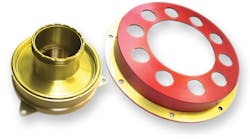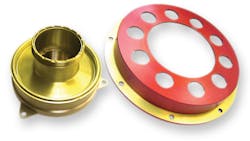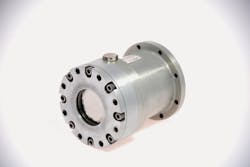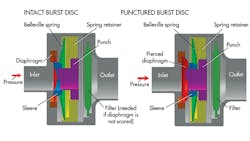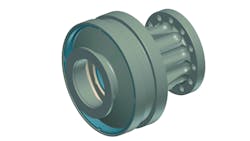How advanced burst discs prevent pressure failures
Many industries, particularly aerospace, rely on pressurized equipment and assemblies such as fuel tanks and propellant subsystems. Burst discs, also referred to as burst diaphragms and rupture discs, protect mission-critical systems from overpressurization and potentially damaging vacuum conditions.
Burst discs
Burst discs usually have steel or aluminum housings and range in size from 0.5 in. in diameter and 0.5 in long to 12 in. in diameter and 6 in. long. They weigh from less than an ounce to 15 lb. On the heavier ones, most of the weight is attributed to the housing and requirements to withstand high pressure.
The key component in a burst disc is the diaphragm. In standard burst discs, the diaphragm is frangible, that is, it ruptures when exposed to pressures exceeding its limit. So if a fuel tank equipped with a burst disc experiences an overpressure, the diaphragm breaks, venting excess pressure (and fuel) to the atmosphere or vacuum of space faster than a mechanical or solenoid-operated valve can. Burst discs also do not leak as valves do, but they also cannot reseal and are one-time-use devices.
Advanced burst discs are more accurate and can be nondestructively tested, thanks to a precision engineered Belleville spring loaded opposite to a punch, i.e., metal-piercing teeth or blade. The spring, or reverse frustum washer, gets preloaded to a calibrated pressure and installed so that it presses firmly up against the diaphragm. When internal pressure from the liquid or gas reaches that calibrated level and transmits it through to the spring, the spring reverses, sending the metal-foil diaphragm through the punch and releasing the pressure.
Diaphragms are made of cold-rolled steel, nickel alloys, or aluminium, but can be made of any other material with a yield strength close its ultimate strength. Diaphragms range in thickness from 0.0003 to 0.015 in., depending on the area and desired burst pressure. Diaphragms can be scored or unscored. Scored diaphragms usually break in a consistent manner and do not create loose fragments. With unscored diaphragms, filters may be needed to catch loose diaphragm fragments if they could potentially cause problems.
Advanced burst discs should be considered not only where replacement costs are high, but also where risks of failure to operate dependably could result in catastrophic consequences.
Advantages of advanced burst discs
Advanced burst discs can be tested by removing the punch device and then increasing pressure on the inlet side until it trips the Belleville spring. Technicians can then confirm the proper trip pressure. The diaphragm withstands this test without degrading its strength. Technicians then reinstall the punch device prior to shipping it to the customer.
Rupture settings can be ±1% of pressures from 1 to 10,000 psi (0.007 to 690 bar), and better tolerances are maintained than standard burst discs at temperatures from –457 to 1,000°F (–271 to 540°C). Rupture-disc settings are relatively impervious to environmental conditions, remaining stable despite shocks (pyrotechnic, operational, crash, and handling) and vibrations (launch, abort, random, sine, and others), while accommodating impulse cycling and resisting fatigue-inducing forces.
NASA considers advanced discs to be the equivalent of two relief valves, letting a single one meet NASA’s two-fault-tolerant requirement (Ref. NASA payload safety requirement NHB 1700.7; NASA-JSC NSTS/ISS 18798; JCS Letter TA-88-074).
The metal diaphragms on advanced discs are edge welded to minimize leaks. Tests on the advanced version show leaks are less than 10-8 standard cubic centimeters per second (sccs).
In aerospace applications, burst discs allow longer missions than relief valves alone. However, a ruptured burst disc quickly releases all of an assembly's pressure. So for applications with pressure minimums or aerospace applications that cannot be recharged, engineers add pressure-relief valves downstream of the burst disc to maintain these minimums. These valves prevent all of the pressure venting and let pressure-dependent mechanisms continue to function but without the same level of overpressurization protection. In addition, advanced burst discs combined with relief valves in the same housing provide space and weight savings of 50 to 80% over other redundant systems.
Advanced burst discs typically offer 99.99% reliability or better over two years of operation. When combined with a downstream pressure-relief valve, the reliability rate climbs to 99.99988%. Mean-time-between failures for a burst disc is typically 1.75 × 108 hr. When used with a relief valve, MTBF goes to 1.52 × 1010 hr.
Recent developments
An advanced dual-directional precision burst disc has being designed and tested for a medium-sized inflight-refueling aircraft. This prototype can be burst by differential pressure from both directions and each side can have a different burst pressure. Any equipment that may be damaged by differential pressure in either direction (internal or external), are candidates for this dual-directional burst disc.
Traditionally, tests on burst discs involved analog gauges with limited accuracy and no time-dependent feedback or data recording. More recently, they have been replaced with precise data-acquisition equipment with high sampling rates. Now, the dynamic performance of burst discs and relief valves is captured to within milliseconds. Temperature and pressure inputs are automated through the use of pressure controllers synchronized with an environmental chamber, and performance data are captured for burst disc and relief-valve assemblies.
Resources:
Technetics Group, Burbank Calif.
